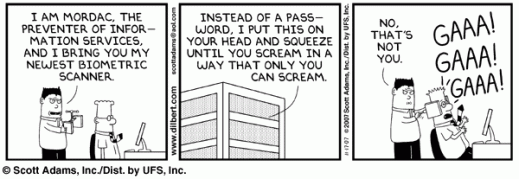This article intend to introduce, a relative cost effective, easy to use and deploy biometric technology.
- Something the person knows
- Something the person has
- Something the person is

Advantages and Comparison of Biometric Technologies
- Increased security
- Eliminate problems caused by forgotten password or user-id
- Robust and Scalable
- Cost Effective
- Easy to use (Exceptions Prevail)
How do I select the best one ?
The table given below compares some of the commonly used biometric technologies based on their usability and cost effectiveness.
| Technology | Cost Effective | Ease of Use | Special Hardware Requirement | Low Maintenance Costs |
| Fingerprints | Yes | Yes | Yes | No |
| Hand Geometry | No | Yes | Yes | No |
| Voice Verification | Yes | Yes | No | Yes |
| Iris Scanning | No | No | Yes | No |
| Facial Recognition | Yes | Yes | Yes | No |
It is clear from the table that the Voice Verification Technology is a more practical solution from the comparison table (Table 0.1).

- Text-dependent version inherently increases recognition performance, but it requires a co-operative user who can remember a phrase or sentence.
- Text-independent version does not even need the user to be aware about the system, which makes it more convenient and secure.
Verification of a person against the Voice Verification System is somewhat similar; where the user will repeat the word or phrase so that the system can compare the voice with the stored template to verify the identity of the person. Based on the verification system rejects or provides access to it.
Robustness : How Reliable is it ?
 The table above compares the different available biometric technologies; it is clearly visible that the EER rate of Voice Verification is lower; it is third major technology in terms of EER. Lower EER rate indicates the better security.
The table above compares the different available biometric technologies; it is clearly visible that the EER rate of Voice Verification is lower; it is third major technology in terms of EER. Lower EER rate indicates the better security.- Remote access is possible, Which can provide an easy and comfortable way to authenticate customers without them physically come down to the organisations location.
- Enable the organisation to provide access to a service with higher level of security irrespective of the customer location.
- Very convenient to use; no more complex passwords or user names or Long alpha-numeric strings for authentication .
- Increased level of trust; which will help in increasing the status quo of organisation.
- Perfect Component of multi factor biometric authentication (something the user knows, something the user is).
- Low implementation costs
- Low maintenance costs
- Reduce in investment, in existing technologies like password recovery,etc
- Easy to use
- Higher Return On Investment
- No Special Training needed for the users; Saves initial training cost.
Compared to the competing technologies Voice Verification provides a Higher Return On Investment Rate.
A 2009 survey by Lieberman research group shows that 69 % of users are willing to use voice verification as a biometric security technique.
Conclusion ! Oh Yeah It might work for me ! (???)Choosing TechnologyThere are a wide variety of products available in the market; which suits different needs and requirements of the organizations or customers. It makes the selection process much easier. Nuance is one of the leading vendors in the market.However there even alternative opensource platforms which can be adapted to custom needs; such as CMU Sphinx by Carnegie Mellon University .The availability of wide range of hardware solutions for cheaper costs is one of the major advantage of choosing voice verification technology.Deployment & MaintenanceThe most easy to deploy biometric technology is Voice Verification; as it does not use any special hardware it is very easy to deploy and maintain. Microphone arrays can be implemented with ease to use it for more demanding environments where more users can verify themselves against the system at once.A remote scenario of phone based voice verification system can easily be managed using a VOIP solution. Which will enable the organization to save a lot of investment amount. There are industry standard opensource VOIP Solutions like Asteriskt available in the market; which are free to download and customise to fit the need of the organisaiton.The users need no additional training to use this technology as some other biometric technologies require training to start with the technology; the users some times even need not know about the existence of technology. This makes it more convenient to manage and maintain.Since it is possible to use universally acceptable voice template databases; the migration to a newer more advanced technology needs no additional enrollments or end-user involvement; which makes it more convenient for future migrations and up-gradations.
[11] Google Labs. (2010). Froogle Search for Microphones.Available: http://www.google.co.uk/products?q=microphone&scoring=p. Last accessed 6 Mar 2010.
[16] Marcia Gulesian. (2007). Speech Authentication Strategies, Risk Mitigation, and Business Metrics. Available: http://www.developer.com/security/article.php/11580_3684921_2/Speech-Authentication-Strategies-Risk-Mitigation-and-Business-Metrics.htm. Last accessed 19 Mar 2010.
[17] ACA Research. (2005). 2005 Speech Recognition Customer Satisfaction Survey.Available: http://www.freeformdynamics.com/misc/docs/Nuance_Customer_Sat_ExecSumm.pdf. Last accessed 19 Mar 2010.
[21] OAM Portal. (2010). Voice Authentication. Available: http://oamportal.fdvs.com/fdvssite/products/voice-biometrics.aspx. Last accessed 19 Mar 2010.
[22] Nuance. (2010). Nuance Website Home Page. Available: http://www.nuance.com/. Last accessed 20 Mar 2010.
[23] Carnegie Mellon University. (2009). CMU Sphinx - Speech Recognition Tool Kit. Available: http://cmusphinx.sourceforge.net/. Last accessed 20 Mar 2010.
[22] Digium. Inc. (2010). Asterisk : Opensource VoIP telephony solutions. Available: http://www.asterisk.org/. Last accessed 20 Mar 2010.
No comments:
Post a Comment